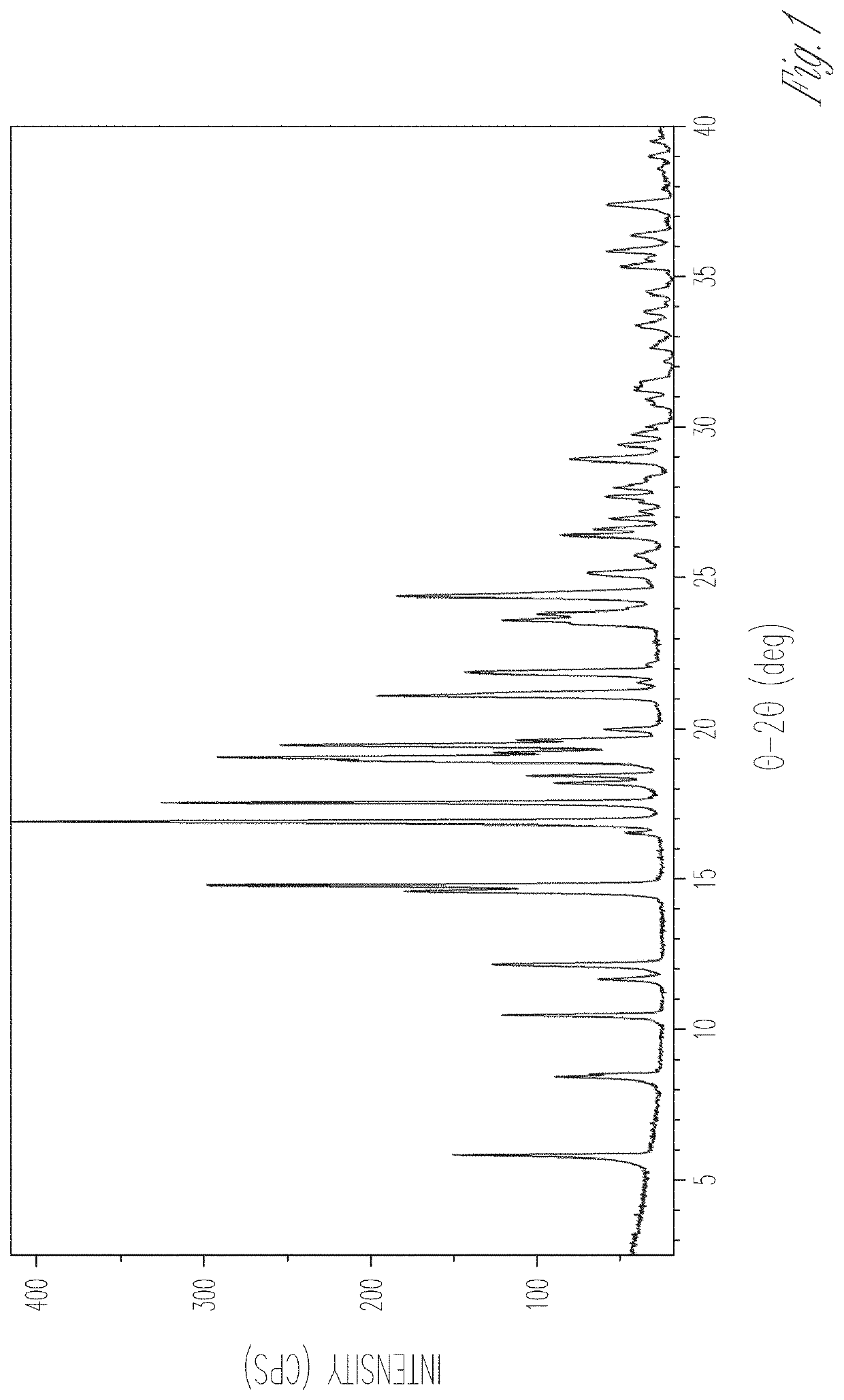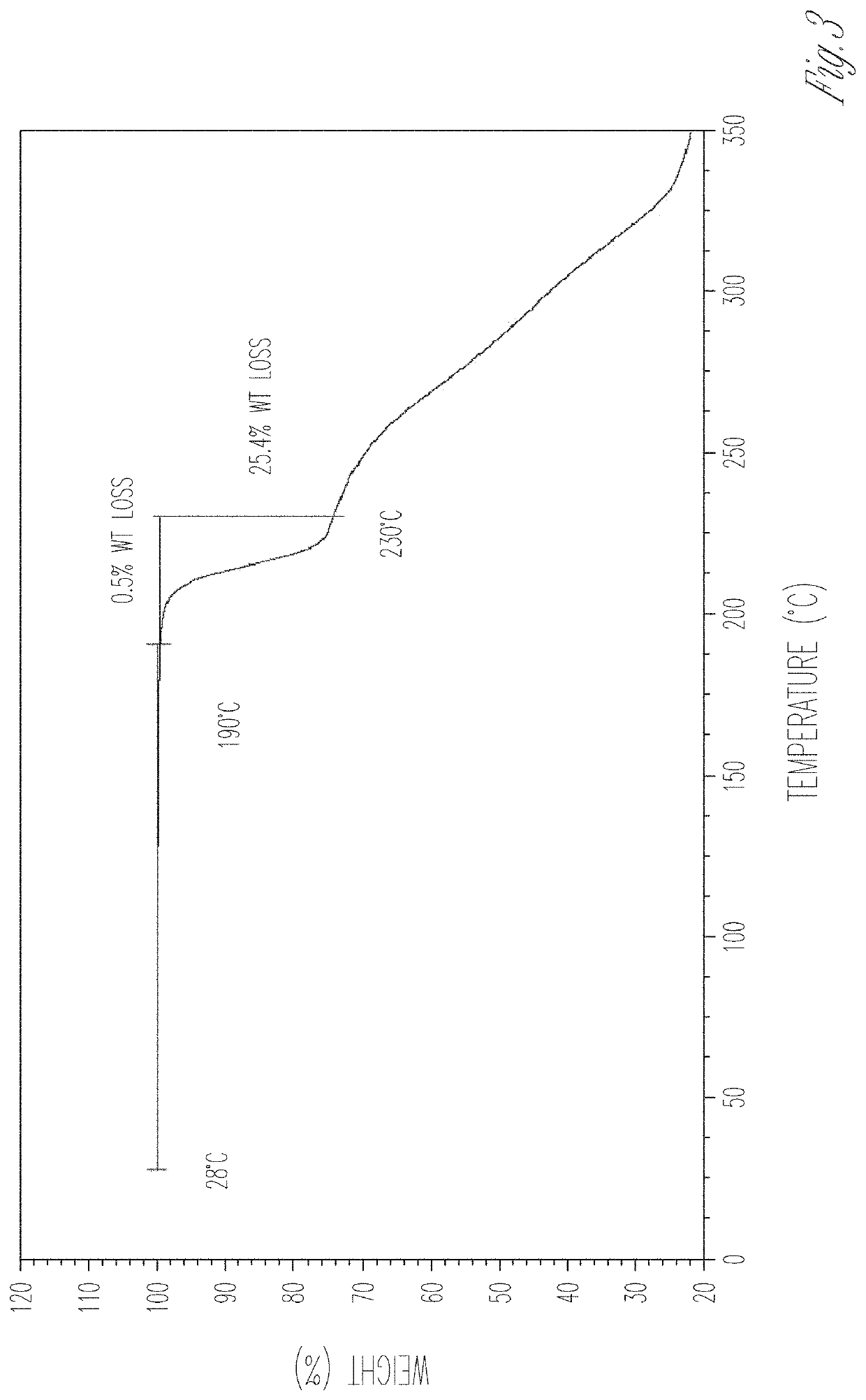Co-crystal forms of a novobiocin analog and proline
a technology of novobiocin and crystal form, which is applied in the field of co-crystal forms of novobiocin analog and proline, can solve the problems of low overall yield, inability to generate large and pharmaceutically pure quantities of -anomer 4a for drug development, and low yield
- Summary
- Abstract
- Description
- Claims
- Application Information
AI Technical Summary
Benefits of technology
Problems solved by technology
Method used
Image
Examples
example 1
of 4a / L-Proline Co-Crystal (Material A)
[0175]
[0176]Compound 4a was obtained by chromatographic separation (HPLC: 4a 96.4% and 4b 1.2%, 500 mg) and was mixed with L-proline (128 mg, 1 eq.) in EtOH (4 mL). The mixture was heated at reflux for 15 min. The hot solution was filtered through a cotton plug. The resulting clear filtrate was cooled slowly and kept at room temperature for 16 h. The precipitated solid was collected by filtration, and dried in air at room temperature to give a 4a / L-proline co-crystal that was designated as Material A (456 mg, 73% yield) as a white solid. M.P. 203-205° C. 1H NMR indicated a ratio of 4a to L-proline as 1:1.1.
[0177]Material A is a 1:1 4a / L-proline cocrystal and it is likely an isostructural solvate. Material A contains a minor L-proline component based on the XRPD pattern (FIG. 23), which was successfully indexed (Table A1). XRPD indexing is typically successful for samples consisting primarily or exclusively of a single crystalline phase. However...
example 2
ion of 4a by Co-Crystallization with L-Proline
[0183]A 500 mg mixture of 4 consisting of compounds 4a and 4b (HPLC: 92.0% of 4a and 7.1% 4b) and L-proline (128 mg, 1 eq) in ethanol (4 mL) was refluxed for 15 min. The mixture was seeded with a co-crystal obtained in Example 1, and the mixture was allowed to cool and then kept at room temperature for 18 h. A white solid was filtered off, while residual solid was transferred out of the reaction flask with the mother liquor. The collected quantity of 4a / L-proline co-crystal (1:1 ratio as determined by 1H-NMR, 497 mg, 79% yield) consisted of 98.0% 4a and 1.49% 4b (analyzed by HPLC).
example 3
l Screen
[0184]Amorphous 4a was utilized in approximately 50 co-crystal screen experiments with 26 co-formers other than L- and D-proline, as summarized in Table 1 below. A variety of crystallization techniques amenable to co-crystal formation was employed, including solvent-assisted milling and manual grinding, cooling, evaporation, slurry, crash precipitation, and reaction crystallization, in which a solution containing a high molar excess of one component is combined with another component to encourage the reaction equilibrium to favor co-crystal formation. A variety of coformers possessing functional groups capable of forming hydrogen bonds was utilized, including carboxylic acids, amino acids, sugars, amides, amines, and numerous functional aromatic compounds. Under the variety of conditions and coformers explored in this screen, however, 4a did not form any confirmed co-crystals with these common coformers.
[0185]
TABLE 14a / CoformerCoformerMolar RatioConditionsTechniqueResultsace...
PUM
| Property | Measurement | Unit |
|---|---|---|
| Angle | aaaaa | aaaaa |
| Angle | aaaaa | aaaaa |
| Angle | aaaaa | aaaaa |
Abstract
Description
Claims
Application Information
 Login to View More
Login to View More - R&D
- Intellectual Property
- Life Sciences
- Materials
- Tech Scout
- Unparalleled Data Quality
- Higher Quality Content
- 60% Fewer Hallucinations
Browse by: Latest US Patents, China's latest patents, Technical Efficacy Thesaurus, Application Domain, Technology Topic, Popular Technical Reports.
© 2025 PatSnap. All rights reserved.Legal|Privacy policy|Modern Slavery Act Transparency Statement|Sitemap|About US| Contact US: help@patsnap.com



